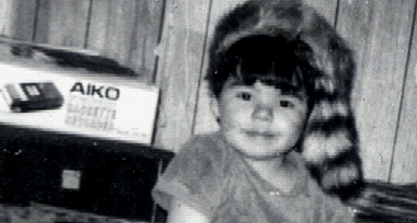Act 2
Most pics click for larger view.

Crossbraces and elbow brackets added to the frame. I hadn't intended to put brackets on this piece, at first, but figured that it may be necessary.

Finished box frame, standing up.

Measuring the length of canvas.

Draping the canvas; making sure all sides are covered, with enough excess canvas to pull on to stretch and tighten.

An initial sharp corner. These need to be blunted, to prevent the canvas from tearing at these points. Especially if you are using a thinner canvas, like muslin (Which is possible to use on smaller canvases; cheaper and easier to find, too).

Rounding off the edges with a hammer. In this case, the back of a hatchet.

A rounded-off corner.
A short discussion of canvas stretching and tightening:
It's hard to show the process; but it is fairly straightforward. After initially "tacking" the canvas in place (once it is draped and all sides accounted-for), a 4"-wide 'point' in the middle of a short side is well-stapled (At least 4 to 5 staples, to a 'point'). Staples are placed on the narrow sides of the 1"x4" board, which will lie against the wall.
The artist then: moves to the opposite point on the canvas, pulls on the canvas with both hands, secures the canvas with left hand (for righties), then staples a 3"-4" wide point between left thumb and index finger with free right hand; keeping left hand in place, until the staples are hammered flat. Go to a point on the other set of parallel sides and repeat. It is important to tighten points opposite of each other, then to move to the perpendicular sides and repeat tightening at opposing points, so that the canvas is repeatedly and consistently tightened, as it is secured.

Tucking, folding and stapling the first corner.

Getting an idea of the size.

Finished canvas, reverse side. Pic is a little fuzzy, because I forgot to switch from "close-up" setting on the lens. Same with next pic.

Pic updated; May9, 06.
Random Pics:

New deathbike, train and mask.

10 000 Broken Vulture Bucks.
Digg it!,Add to del.icio.us,
Googlize this post!,Save to newsvine!,Add to RawSugar
Spurl this!,tagtooga This!,Add to MyWeb
Add To Any Service!,Sphere it!
Tags:
bingorage,blog,mask,art,pics,native art,sculpture,painting,canvas,train,canvas building,carpentry,Fort Frances,northwestern ontario


5 comments:
That is one big canvas...haha, looking great, cant wait to see what develops!
Me too. I would be very interested to see the finished artwork as well as work in progress as I don't imagine this is going to a very quick piece to do.
By the way, I just finished writing an eBook on Native art and it can be downloaded by all for absolutely free at http://www.FreeSpiritGallery.ca/nwartebook.htm
Clint
Free Spirit Gallery
http://www.FreeSpiritGallery.ca
w/a canvas that big one must be extra carefull when throwing tomahawks around in the studio...
Right on... it's coming along nicely. Are you ready to begin painting, or do you need to "prep" the canvas first?
The deathbike is a nice touch for a sense of scale. :)
Will; I already said I was sorry.
:-)
JLB; I will need to prime the canvas before starting the painting. And create the 3D papier-mache parts, first, too.
Post a Comment